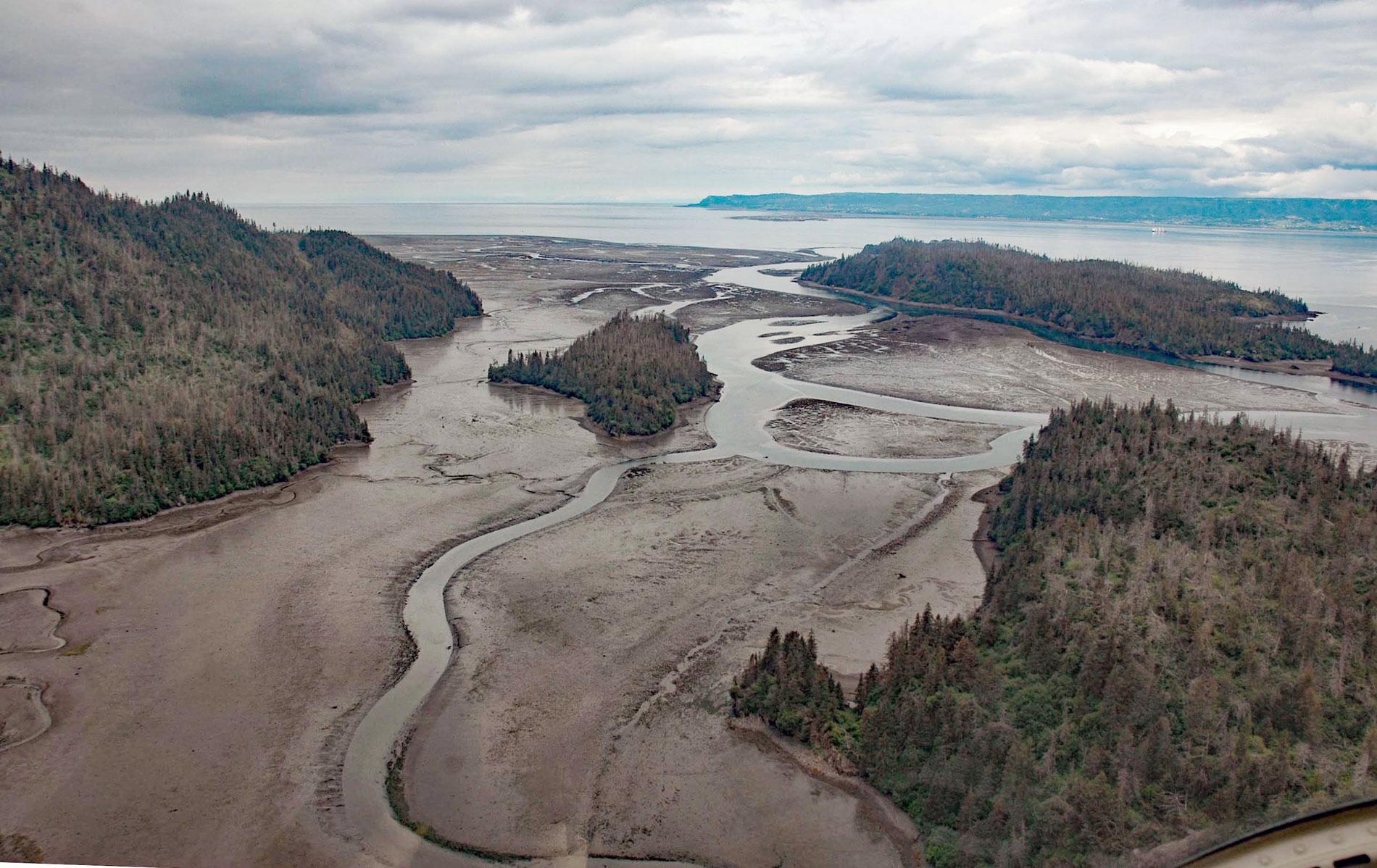China Poot Creek starts at an elevation of about 3,500 feet (1,067 m) on the western flank of the Kenai Mountains and flows for 5.6 miles (9 km) to China Poot Lake, also called Leisure Lake, at an elevation of 168 feet (51 m), and then for another 0.9 miles (1.5 km) to China Poot Bay on the southeastern shore of Kachemak Bay, about 19 miles (31 km) northeast of Seldovia and 13 miles (21 km) southeast of Homer, Alaska. The name refers to Henry ‘China’ Poot an Alaska Native, born in 1870 and resident of Seldovia in 1910, who fished and trapped in this area. The name was first reported in 1911 by George C. Martin who surveyed the geology and mineral resources of Kachemak Bay for the U.S. Geological Survey. The creek drains a watershed of 9,500 acres (3,845 ha) and is formed by glacier scoured bedrock representing the McHugh Complex which is part the Valdez Group of the Southern Margin Composite terrane, which developed during the Late Cretaceous as deposits of turbidity currents in an oceanic trench. The higher elevations of the watershed above China Poot Lake consists primarily of complexly deformed partially metamorphosed greywacke sandstone, siltstone, and shale. Below the lake, the creek has incised pillow and massive basalt overlain by complexly folded and faulted radiolarian chert.
Kachemak Bay has high biological productivity compared to other areas of lower Cook Inlet, and this is likely due to the climate, topographic and bathymetry terrain, and habitat diversity. The bay has no major salmon runs but land mammals, sea mammals, birds, halibut and cod are abundant. Several embayments on the southern shore had historical runs of Pacific herring before the populations were depleted by commercial fisheries. Most archaeological sites occur along the southern coast or on islands. The first maritime hunters appear in the archaeological record about 4,500 years ago and were of the Ocean Bay tradition, probably coming from the Alaska Peninsula. Then, about 4,000 years ago, technology related to the Arctic Small Tool tradition of the Alaska Peninsula appeared in the bay. About 3,000 years ago, sea hunters of the Kachemak tradition with close connections to Kodiak Island were established in the bay and developed a distinctive culture over a period of 1,500 years and then disappeared from the archaeological record. About 1,000 years ago, Dena’ina Athabaskan people arrived from the Alaska interior and adopted a maritime hunter-fisherman subsistence economy. A historical Dena’ina village or camp called Tsayehq’at, meaning ‘place below rock’, was located in China Poot Bay. Another village called Soonroodna was located nearby and was visited by Johan A. Jacobsen in 1883. The archaeological record indicates that periods of famine were common and the failure of these early cultures to develop a permanent presence in the bay may suggest that the habitat was marginal for sustaining a large human population, especially without a major salmon stream.
China Poot Lake has no natural sockeye salmon population due to an impassable waterfall located approximately 326 feet (100 m) from the creek mouth at China Poot Bay. Since 1976, the lake has been stocked with sockeye salmon fry by the Alaska Department of Fish and Game to enhance commercial and sport fisheries, starting with 60K fingerlings in 1976 and increasing to 2M fingerlings by 1983. However, increased stocking density led to decreased growth and survival of juvenile sockeye salmon suggesting that the lake reached its carrying capacity of sockeye salmon fry in a natural system. The lake is oligotrophic and characterized by low phosphorus and nitrogen concentrations, low chlorophyll-a, and a low abundance of zooplankton. From 1985 to 1992, the lake was the site of a nutrient enhancement program to stimulate algae growth and increase the abundance of zooplankton with the goal of increasing the survival and growth of juvenile salmon. During all treated years, there was a 40 percent average increase in zooplankton biomass and 50 percent average increase in smolt biomass compared to pretreatment years which demonstrated that nutrient treatment of some oligotrophic lakes can produce an environment that results in a greater biomass of smolts. In 1993, this operation was assumed by the Cook Inlet Aquaculture Association. Salmon fry rear in the lake for one to two years before migrating to saltwater as smolt. In the marine environment, they grow rapidly, returning to the creek in two or three years as adults weighing 4 to 6 pounds (1.8-2.7 kg). Adult returns are managed as a terminal fishery, aggregating in China Poot Bay and at the base of the waterfall. Most are caught by sport, personal use dip net, and commercial fishermen. Read more here and here. Explore more of China Poot Creek and Kachemak Bay here:

